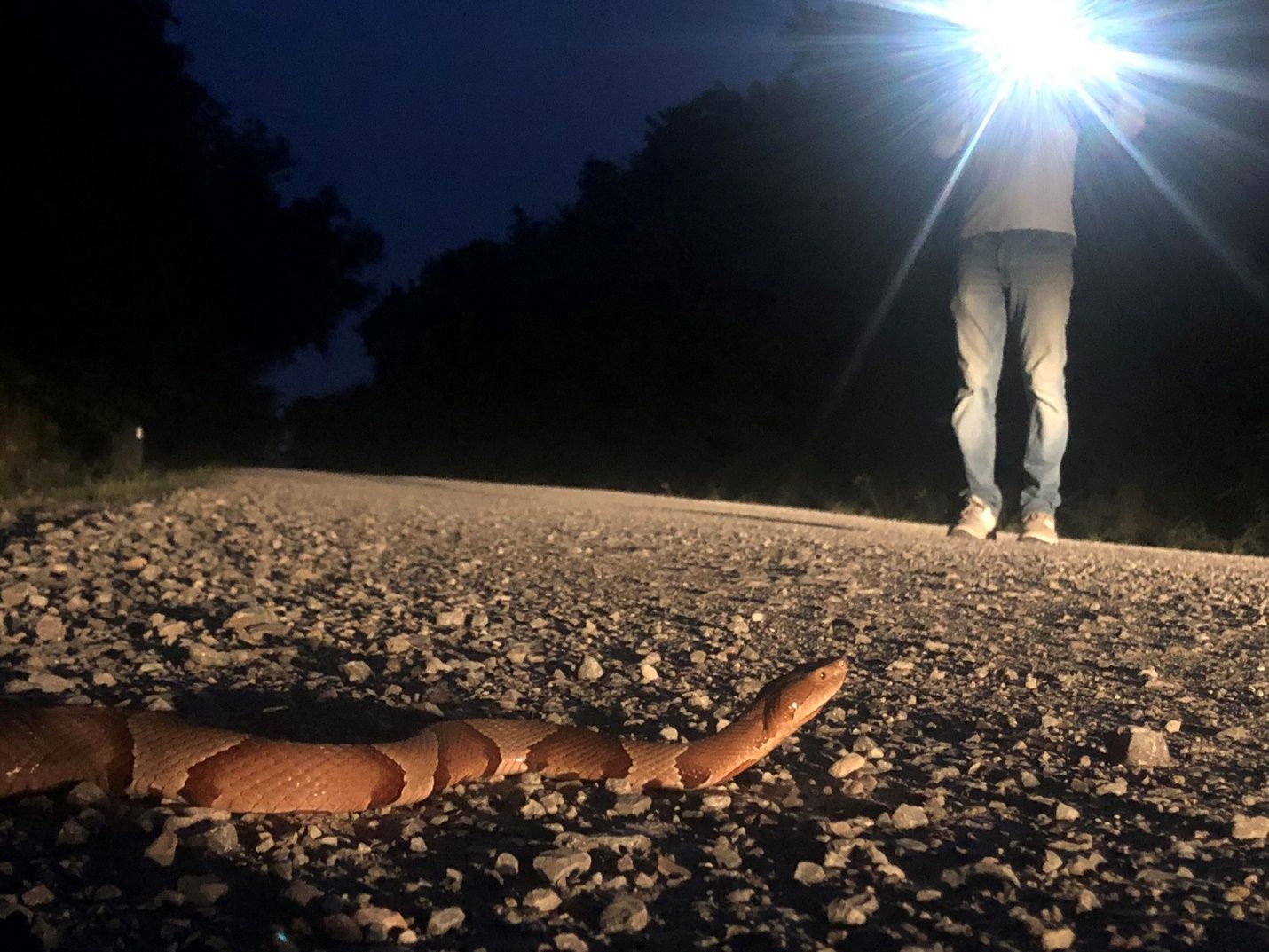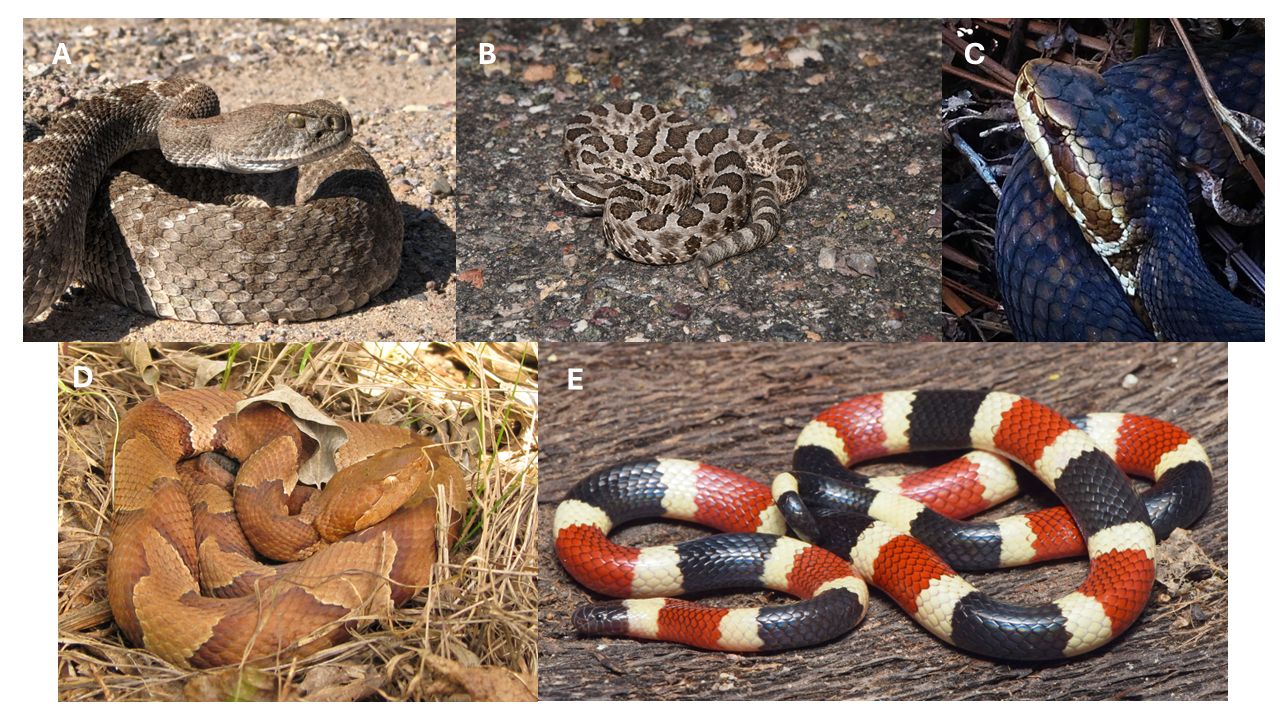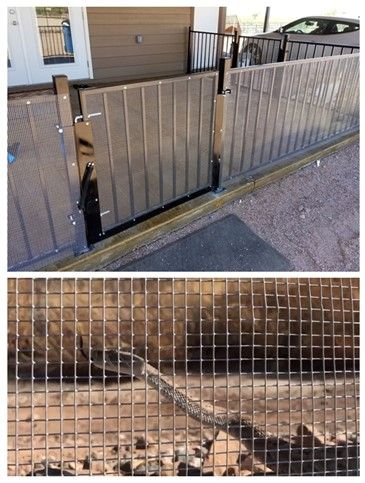Introduction
The United States is home to a wide variety of venomous snakes, many of which can be found near human developments. While historically these animals have been regarded as nuisances and threats that need to be eradicated, ecology tells us a different story. In fact, venomous snakes play critical roles in their ecosystems, and removing them may cause severe problems for both environmental and human health. Snakes occupy an important place in the food web, serving as both predators (e.g., to rodents, frogs, and birds) and prey (e.g., for birds of prey, wild canines, and wild felines). In fact, scientists have estimated that apex predators, like rattlesnakes, can reduce the incidence of Lyme disease in localized areas by preying upon rodents and thus reducing the tick population (Kabay, Caruso, and Lips 2013). Rodents are the hosts of ticks, which carry the bacteria that cause this debilitating disease.
As urban and residential landscapes grow and develop, less and less habitat is available for wildlife, including venomous snakes. However, being resourceful and adaptable animals, snakes will often take advantage of human-made habitats available to them in the urban/wildland interface. The purpose of this publication is to provide homeowners within the United States, especially in the Southwest, where rattlesnakes are quite diverse, practical strategies for coexisting with venomous snakes. Remember, we choose to live in their habitat, so taking these steps for peaceful coexistence is a smart decision not only for your safety and the safety of your family and your pets but also for the well-being of the natural environment in which we all live, which in large part depends upon the snakes whose habitats we share.
Venomous Snakes in the United States
Venomous snakes are found in 46 of the 48 states in the lower continental United States (Ernst and Ernst 2003). As you might expect, the greatest diversity is found in the warm southern states. Arizona, with its incredibly rich diversity of rattlesnakes, takes the prize for greatest species richness of venomous snakes with 13 species (Stebbins 2003).
Most of the venomous snakes in the United States are pit vipers. These include the copperheads (Figure 1 and Figure 2D), cottonmouths (also known as water moccasins) (Figure 2C), and all the rattlesnakes (Figure 2A and B). They get the name “pit viper” because of a specially adapted heat-sensing pit located in front of the eyes (Figure 2A) used for detecting their prey and finding places to hide that provide them with suitable temperatures.

Credit: Brandon Bourassa, UF/IFAS
The other group of venomous snakes of concern in the United States is the elapids, relatives of cobras and kraits. In the Americas, this group is represented by coral snakes and yellow-bellied sea snakes. While coral snakes come in a wide array of colors and patterns throughout their ranges in Central and South America, here in the United States, they are a brilliant, tri-colored (red, yellow, and black) snake with a slender, almost pencil-thin body.

Credit: A, C: Brandon Bourassa, UF/IFAS; B, E: Wolfgang Wüster; D: Richard Reams
Another group, the colubrids, includes kingsnakes, ratsnakes, gopher snakes, and others. Many colubrids are technically venomous, but none of the US snakes within this group has a venom normally of medical concern to humans or pets.
Identifying Venomous Snakes
There is no surefire distinction between venomous and nonvenomous snakes that can be learned simply by reading about it in a publication like this. In most cases, if you are unsure, it is best to treat all snakes as venomous by keeping a respectful distance and refraining from handling or harassing them. Many harmless species have evolved to closely resemble venomous snakes. For example, harmless scarlet snakes and scarlet kingsnakes have evolved to closely resemble venomous coral snakes (Figure 2E). And it’s a fallacy that any snake with a triangle-shaped head is venomous. Many species of harmless snakes will flare their jaws and flatten their heads, making their heads look triangular when they feel threatened. As a result, many harmless species suffer from the same persecution as their venomous counterparts.
The key to identifying snakes is to first determine which species can be found in your area. This will help you to narrow down the list of species and make it much easier to learn about them. Distribution maps can be found in field guides and online resources, many of which are specific to a state or region. Some online resources are listed at the end of this publication. Some areas have more venomous snakes than others (e.g., Arizona vs. Nebraska), but every region in the United States has a greater diversity of harmless species than venomous species. If you focus on becoming skilled at learning to recognize the venomous pit vipers and, depending on your location, coral snakes native to your area, it will make the task of differentiating between venomous and nonvenomous snakes much simpler.
You do not need to become a snake expert or even take interest in the topic to identify snakes effectively. Today, there are numerous resources on the internet and social media to aid in the quick identification of snakes using photographs. Take a moment in advance to search for an identification resource where you can send a request for identification should you need one. Your resource could be a Facebook group, a website, a herpetological society, or even a knowledgeable individual.
If learning to identify snakes sounds like a chore, it doesn’t have to be! Most children are naturally curious about animals, so snake identification can become a fun family activity. Pick up a field guide for your locality and take the kids hiking in a natural area. The “Seek” app by iNaturalist can be another useful and fun tool for family nature outings. If you find a snake, teach your kids to appreciate and respect the animal from a distance of several feet (well out of strike range). Interactions like this are vital for dispelling the many myths and misunderstandings about snakes. Don’t live near an accessible natural area? Most zoos will have a collection of venomous snakes from your area and around the world, and many zoos and nature centers even have hands-on educational activities and classes for you and your family to learn about snakes and other wildlife.
How do I discourage venomous snakes from living in my yard?
Property Maintenance
The best way to start reducing your risk of encountering a venomous snake is simple: keep your property free of clutter and potential hiding places. Many people think of snakes primarily as predators, but in fact they are prey for a host of animals like coyotes, birds of prey, and other snakes. Because they are so vulnerable to so many predators, snakes seek out places to hide, like heavy vegetation, logs, boards, or sheet metal, and decaying structures such as sheds, barns, or abandoned houses. A well-maintained property lacks such hiding places for snakes, and has the added effect of keeping rodents away. Rodents are the prey of many snakes, especially rattlesnakes. If you live on a large property, create a buffer zone of well-trimmed vegetation around your dwelling and keep this area free from clutter and debris. Snakes avoid open, clear spaces and are more attracted to natural habitat that is allowed to grow normally because it provides them the cover they need to hide from predators. Remove old structures that are no longer in use, and repair or replace any necessary structures to prevent rodent infestations. To further dissuade rodents, store potential attractants (grain, bird seed, pet food) in closed, metal containers. Be sure to locate compost bins/piles near the edge of your property. Stay away from glue traps and rodenticides, as these are frequently perilous for far more wildlife, not to mention pets, than for their intended targets.
Many homeowners prefer native plants in their landscape for water conservation and to benefit native wildlife like pollinators. We certainly encourage native landscapes. However, keep in mind that an ecologically friendly residential landscape also includes beneficial predators like snakes. If you want your property to be a flourishing habitat full of native plants and attractive to native wildlife, coexisting with all wildlife that may show up is crucial.
Snake Fencing
In parts of the country, like Arizona, specially designed fencing (Figure 3) is available to exclude rattlesnakes from yards. If installed properly, this fencing material is highly effective at keeping large-bodied, ground-dwelling snakes out of yards. Both harmless arboreal (climbing) snakes and venomous coral snakes may be able to find their way past your snake fencing, so it is, again, very important to remember that any snake you cannot identify with total confidence should be treated as venomous and left alone.
To be most effective, these fences must be properly installed by individuals who understand snake behavior. If the slightest gap exists, snakes will find it, and you may end up trapping them inside, exactly where you didn’t want them. In fact, if an area you want to protect cannot be entirely enclosed by snake fence installation, including gates and drains, none should be installed at all.
Based on snake behavior and physiology, the measurements for effective snake fencing are as follows:
- Gaps must be no greater than a quarter inch, including along gates and drains.
- The fence must extend at least 36 inches high from the nearest climbable or flat surface.
- Any mesh or preventative materials, when installed against dirt or an unsolid surface, should be trenched into the ground to a depth of at least 6 inches and positioned at a slightly outward angle.
These snake fence specifications have been implemented with great success in Arizona and should be effective for excluding venomous snakes around the country.
While the use of these fences is becoming more accepted in Arizona, other areas of the country could likely benefit from their use as well. For example, newer developments in Florida that back up to forests and freshwater habitats like cypress swamps often create conflicts with venomous species like cottonmouths (Figure 2C). Properly installed snake fencing would effectively reduce conflict with all of Florida’s native venomous species, with the possible exception of coral snakes, which are unlikely to pose a threat unless they are handled. If you are a contractor interested in learning how to install snake fencing properly, contact the lead author of this publication and he will direct you to the appropriate resources. Easily installed silt fencing, which is primarily used to prevent soil erosion, may be effective at keeping coral snakes out if it is tall enough and if all gaps are covered. It may be necessary to place the silt fencing in a small trench three or more inches deep to exclude coral snakes, which spend much of their lives underground.

Credit: Bryan Hughes, Rattlesnake Solutions
How do I keep my pets safe from venomous snakes?
It’s not uncommon for veterinarians to treat snake bites in dogs. While dogs usually recover just fine, treatment can be very costly and the whole experience is painful and traumatic for your pet, so it is best to prevent encounters in the first place. Many professional dog trainers offer snake aversion training, but these services are frequently costly, may not be available in your area, and are not effective for every dog. You may also have heard about the snakebite vaccine for dogs. Unfortunately, this vaccine may sensitize dogs to anaphylaxis (Petras, Wells, and Pronko 2018), so it is not recommended. If you live in an area where dogs are likely to encounter venomous snakes, your best bet is to keep your pets confined to a secure, snake-proof pen or keep them on a leash when they are outside.
What about outdoor cats? Can they be kept safe from venomous snakes? The answer, unfortunately, is no. In fact, keeping cats indoors is the only sure way to keep them from encountering venomous snakes. You can keep your cat safe and happy inside by providing enrichment opportunities and as much mental and physical stimulation as possible. You can also purchase commercially available “catios” or have fun designing and building one of your own to allow cats safe access to the outdoors. Just be sure to follow the same guidelines for snake-proofing provided in this publication.
What do I do if I encounter a venomous snake?
The key to avoiding snakebite is simply to leave snakes alone. Many envenomations in the United States are the result of foolish behavior on the part of the humans involved. In fact, a disturbingly large number of snakebite incidents in the United States, up to 40%, according to one study, involve alcohol consumption by the snakebitten person (Morandi and Williams 1997). To avoid a bite from a venomous snake, leave the snake alone and don’t try to catch, kill, or harass it. If your property is well-maintained and there are no attractive shelters for the snake, it is likely just passing through and will move on to richer hunting grounds and safer shelter. Just give it some time and be cautious; the snake will likely leave within 24 hours.
If leaving the snake alone is not practical, if, for instance, it is near a doorway or under a vehicle, you may want to try to gently discourage the snake from staying. Try spraying it with a water hose in the direction you’d like it to move.
If a venomous snake appears to be taking up residence on your property, do not attempt to kill it or try to remove it unless you have had proper training. Contact your state’s wildlife officials or an organization like a local herpetological society for advice. Many agencies or organizations will offer assistance for relocating a venomous snake from your property. It is a good idea to identify these resources before you need them to avoid delays during a snake emergency, especially if you live in the wildland-urban interface.
If you are interested in learning to handle venomous snakes on your property safely, the Rattlesnake Conservancy (http://www.savethebuzztails.org) offers training courses across the country. If attending a training like this is not an option, you can inquire with local zoos and nature centers about volunteering with their experienced reptile keepers who may be able to demonstrate proper handling methods, although their insurance may prevent you from doing the handling yourself. Herpetological societies can also be a wonderful resource, especially if they participate in field trips and surveys.
What kinds of venomous snakes are in my area?
Numerous field guides and online resources will help you identify and learn about snakes in the United States. Conduct an internet search using terms such as “snake” and “identification,” and include the state of interest to locate online resources that will help you learn more about snakes in your area. As you conduct your search, remember that not all online resources are equal. Ensure that you are looking at reputable sources. Additionally, platforms like iNaturalist can show you which species have been observed in your area and may be useful for verifying other online sources.
Conclusion
Many of us were taught from a young age that snakes are to be feared, but the reality is that we benefit from the presence of these misunderstood animals. While it is not necessary to love snakes, a healthy respect and a willingness to coexist with these and other predatory animals with which we share our surroundings will serve to keep our natural communities functioning and our ecosystems flourishing. It is true that certain animals present some element of danger, but taking the simple steps addressed in this publication, learning about your local wildlife, and simply leaving snakes alone can substantially reduce your risk. It cannot be emphasized enough that many venomous snake bites occur when people are attempting to kill or otherwise harass snakes. Leave removals and relocations to the professionals or wait for the snake to move on its own. Never take unnecessary risks with a venomous snake.
For more information, refer to the additional resources provided below.
Snake Resources
Snake Fencing
Rattlesnake Solutions https://rattlesnakesolutions.com/
Central Coast Snake Services https://www.centralcoastsnakeservices.com
Handling and Safety Training
The Rattlesnake Conservancy https://www.savethebuzztails.org/
Central Coast Snake Services https://www.centralcoastsnakeservices.com
Aversion Training for Dogs
Southeastern Reptile Rescue Snake Aversion Training Schedule https://www.snakesareus.com/snake_aversion_training
Rattlesnake Aversion Training by Natural Solutions https://socalrattlesnakeavoidancetraining.com
General Resources
Advocates for Snake Preservation’s “Living with Snakes" http://www.livingwithsnakes.org
iNaturalist https://www.inaturalist.org
iNaturalist Seek App https://www.inaturalist.org/pages/seek_app
Secrets of Snakes (a book by Dr. David Steen) https://www.tamupress.com/book/9781623497972/secrets-of-snakes/
Dealing with Snakes in Florida’s Residential Areas – Emergency Planning https://edis.ifas.ufl.edu/publication/UW261
References
Ernst, C. H., and E. M. Ernst. 2003. Snakes of the United States and Canada. Smithsonian Books, Washington. 668 pp.
Kabay, E., N. M. Caruso, and K. Lips. 2013. “Timber Rattlesnakes May Reduce Incidence of Lyme Disease in the Northeastern United States.” Ecological Society of America Annual Conference, 98th, Minneapolis, Minnesota, August 4–9, 2013. www.researchgate.net/publication/267289888
Morandi, N., and J. Williams. 1997. “Snakebite Injuries: Contributing Factors and Intentionality of Exposure.” Wilderness and Environmental Medicine 8:152–155.
Petras, K. E., R. J. Wells, and J. Pronko. 2018. “Suspected Anaphylaxis and Lack of Clinical Protection Associated with Envenomation in Two Dogs Previously Vaccinated with Crotalus atrox Toxoid.” Toxicon 142:30–33. https://doi.org/10.1016/j.toxicon.2017.12.044Get rights and content
Stebbins, R. C. 2003. A Field Guide to Western Reptiles and Amphibians, 3rd Edition, Houghton Mifflin Company, Boston. 533 pp.